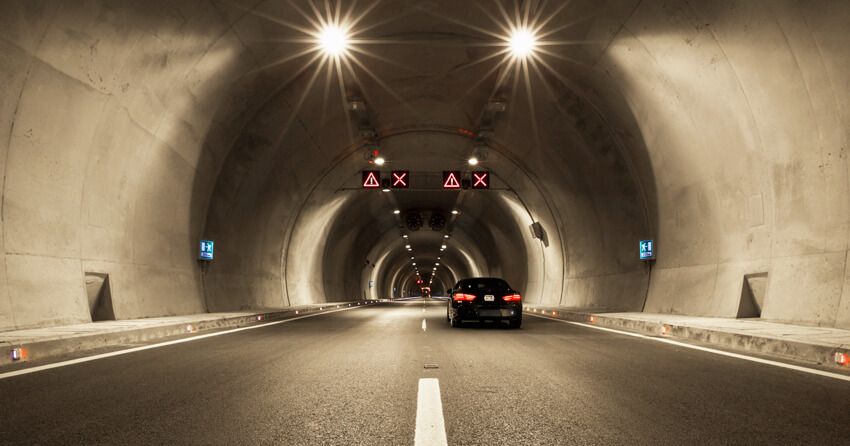How innovation improves tunnel fire safety
07/02/2025
Tunnels play a crucial role in modern transportation, facilitating road and railway traffic worldwide. However, they also pose significant tunnel fire risks, which can lead to major disaster. Innovation in fire prevention, fire detection systems, and emergency response has become essential to improve tunnel safety. This article explores the causes and consequences of tunnel fires and highlights the latest technologies, including firefighting robots, that enhance safety in underground spaces.
Understanding fire risks in tunnels
What are the causes of fires in tunnels?
Tunnel fires typically result from several key factors:
- Mechanical failures: short circuits, overheating engines, or fuel leaks can ignite fires, particularly in heavy vehicles.
- Traffic accidents: collisions, especially those involving hazardous materials, significantly increase the risk of large-scale tunnel fires.
- Human errors: unauthorized transport of flammable substances, improper vehicle maintenance, and negligence can lead to fire outbreaks.
- Flammable materials: the use of non-fire-resistant construction materials and cargo accelerates fire spread.
Why are tunnel fires so dangerous?
Unlike open-air fires, tunnel fires are exacerbated by limited ventilation and space, leading to intense heat and dense smoke accumulation. The structure of tunnels can also trap people and rescue teams, making evacuation difficult. The depth of the tunnel, and their closed environment make the investigation harder and more dangerous for firefighters.
Human and economic consequences
Human consequences of tunnel fires are severe and often tragic. Tunnel fires dramatically increase the risk of casualties and injuries due to toxic smoke, extreme heat, and the challenges of evacuation in a confined space.
Firefighters face unique challenges during tunnel fire emergencies, including limited visibility, restricted access, and the need to navigate long distances. Their breathing apparatus typically provides only 20 to 30 minutes of air, but reaching the source of the fire in a tunnel can take much longer. These human consequences make tunnel fires some of the most dangerous emergencies, highlighting the importance of effective tunnel fire safety measures and emergency response planning.
Economically speaking, a tunnel fire can have devastating economic consequences that extend far beyond the immediate costs of repairing structural damage. The direct expenses include the restoration of the tunnel itself, such as replacing damaged concrete, safety systems, and electrical fittings, which can run into millions of euros. For example, the 2008 Channel Tunnel fire incurred €60 million in repair costs, while the disruption to rail services resulted in an additional €200 million in lost business.
Beyond these direct losses, the closure of a tunnel leads to significant secondary economic impacts: operators face lost toll revenues, and the diversion of traffic causes increased travel times and logistical costs for thousands of vehicles daily. Furthermore, the ripple effects can harm local businesses, disrupt supply chains, and even result in job losses. The cumulative economic burden of a major tunnel fire, therefore, encompasses not only the tangible costs of physical repairs but also the broader, often much larger, costs of service disruption and economic inactivity in the affected region.
Case study with the Mont Blanc tunnel fire
One of the most catastrophic tunnel fires happened in March 1999 into Mont Blanc Tunnel. This is a road tunnel long of more than 2000 metres connecting France and Italy (from Chamonix-Mont-Blanc in the Chamonix Valley, France, to Courmayeur in the Aosta Valley, Italy) through the Mont Blanc massif. This catastrophic fire led to the deaths of 39 people including driver of the truck involved, other drivers and firefighters. It all started with a burning truck carrying flour and margarine, causing a dense smoke build-up. The intense heat and lack of immediate control turned the incident into a major disaster. The aftermath led to significant renovations and stricter fire safety regulations in tunnels.
Prevention and detection technologies
Advanced ventilation systems
Tunnel ventilation systems are essential to ensure the safety and comfort of users. They serve several crucial purposes:
- Pollutant evacuation: Vehicles emit harmful gases such as carbon monoxide and particulate matter. Ventilation allows these pollutants to be diluted and evacuated, thus maintaining acceptable air quality.
- Smoke management in case of fire: In the event of a fire, ventilation plays a vital role by evacuating smoke and heat, allowing users to escape and facilitating emergency services intervention.
- Temperature control: In long tunnels, ventilation helps regulate temperature, preventing overheating.
Here are some types of ventilation systems used in tunnels:
- Longitudinal ventilation: uses fans to create an airflow along the length of the tunnel. It is effective for low-traffic and moderately long tunnels.
- Transverse ventilation: extracts polluted air through ducts located above the roadway and introduces fresh air through side ducts. It is more effective for high-traffic and long tunnels.
- Semi-transverse ventilation: combines the principles of longitudinal and transverse ventilation. It uses fans to create a longitudinal airflow and ducts to extract polluted air.
The design of a tunnel ventilation system depends on several factors, including: the length and diameter of the tunnel, the volume and type of traffic, climatic conditions, fire safety requirements.
Automatic smoke and heat detection
Advanced tunnel safety relies on automatic detection systems:
- Smoke detectors alert to smoke particles, signaling possible fire.
- Heat detectors trigger alarms if temperatures rise rapidly.
- Thermal cameras visualize heat sources through smoke.
- Linear heat detection uses heat-sensitive cables for long-distance monitoring.
- Intelligent video analysis automatically spots smoke or flames in surveillance footage.
These technologies, combined with routine maintenance, ensure critical safety features, like ventilation, lighting, and fire alarms, work effectively for emergency response and to minimize incident impacts.
Importance of infrastructure maintenance
Maintaining detection and prevention systems is essential to ensure continuous operability and security in tunnels. Regular upkeep of these systems, such as smoke and heat detectors, fire alarms, and emergency lighting, helps minimize the risk of accidents and ensures rapid response in case of emergencies. Just as well-maintained road surfaces reduce the risk of traffic accidents, proactive infrastructure maintenance prevents deterioration, system failures, and costly disruptions.
New standards in fire safety
Following previous incidents, new safety regulations have been introduced to improve fire response in tunnels. New fire safety standards in tunnels focus on faster detection and suppression, improved ventilation, reinforced structures, and safer evacuation. They integrate advanced technologies like AI for video analysis, water mist systems, and fire-resistant materials, while emphasizing training and international standards. In March 2025, RED rescue & safety developed an innovative solution: the Xtreme Tunnel Rescue Kit. The main goal? Equipping operational teams with hi-tech and cutting-edge tools, capable of ensuring timely and effective interventions in complex emergency scenarios. The integration of such technologies represents a significant advancement in fire safety standards, offering improved efficiency and protection during tunnel fire incidents.
Firefighting robots : an innovation against tunnel fires
Presentation of the Colossus by Shark Robotics
The Colossus, developed by Shark Robotics, included in the Xtreme Tunnel Kit, is a firefighting robot designed to assist human teams in extreme environments. The heavy firefighting robot, developed in collaboration with the Paris Fire Brigade (BSPP), is engineered to redefine firefighting capabilities in extreme environments. This robust robot excels in critical missions such as fire suppression, casualty evacuation, and equipment transport. Notably, during the fire at Notre-Dame Cathedral in Paris, Colossus showcased its extraordinary resilience and effectiveness, operating under extreme heat conditions for over 10 hours, significantly aiding firefighters in protecting the iconic structure. Its capabilities make it ideal in tunnel fire situations. Where humans can stay only a few minutes, the Colossus can intervene for hours.
How these robots are revolutionizing tunnel firefighting
Firefighting robots like the Colossus improve tunnel fire safety by providing rapid intervention in toxic and high-temperature environments. Their ability to enter confined spaces and operate for extended hours ensures better protection for firefighters and people trapped. They may be equipped with a special air system, allowing intervention forces to remain oxygenated longer than their usual equipment thanks to 6 oxygen bottles.
Organizing an effective response in case of tunnel fire
Evacuation protocols and refuge areas
Tunnels include well-marked evacuation routes and refuge areas where people can remain safe until rescue teams arrive. Refuge areas can be:
- Cross-passages: Connecting adjacent tunnel bores for safe passage.
- Pressurized Chambers: Sealed rooms with independent ventilation to prevent smoke ingress.
- Emergency Niches: Small protected spaces with communication systems.
Coordination between brigades and the use of technologies
Effective coordination between emergency services is critical in managing tunnel fires, where time and visibility are limited. Clear communication protocols, joint training exercises, and shared command structures ensure that firefighters from different brigades can act swiftly and cohesively. In parallel, modern technologies such as real-time monitoring systems, automatic incident detection, and remote-controlled firefighting robots enhance situational awareness and operational safety. These tools allow responders to assess risks, locate victims, and combat fires without direct exposure to extreme conditions, significantly improving overall response efficiency.
Team training in the use of advanced equipment
To ensure maximum efficiency during underground fire interventions, firefighters must be thoroughly trained to operate advanced firefighting tools such as robots and sensors. At Shark Robotics, we provide dedicated training to every fire brigade that deploys one of our firefighting robots, ensuring they are fully prepared to use the technology effectively in real-world scenarios.
Tunnel fires remain one of the most challenging emergencies for both human safety and infrastructure resilience. Thanks to ongoing innovation in detection, prevention, and response, such as advanced ventilation, AI-powered monitoring, and firefighting robots, the risks can be better managed. However, continuous investment in technology, training, and international collaboration is essential to ensure tunnels remain safe for all users.
Questions
What was the deadliest tunnel fire?
The deadliest tunnel fire in history occurred in the Mont Blanc Tunnel. Tragically 39 people died.
What are the upcoming innovations to fight tunnel fires?
Future advancements include AI-driven fire detection, enhanced ventilation controls, and more robust firefighting robots capable of autonomous operations.
What are the notorious examples of tunnel fires?
Some of the most major tunnel fires include:
- The Mont Blanc Tunnel fire (March 1999)
- The Gotthard Road Tunnel fire (October 2001)
- The Channel Tunnel fire (November 1996)
Contact our communications team
